During the 1960s and 1970s handsome French actor Laurent Terzieff (1935-2010) starred in many films by noted French and Italian directors. The magnetic and politically engaged actor began his film career as one of the existential youth in Les Tricheurs (1958) and later often portrayed cynical bohemians or political activists.
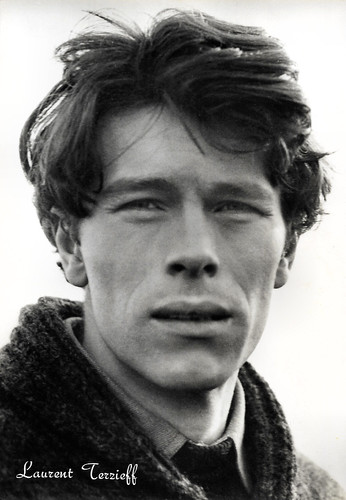
Italian postcard by Rotalfoto, Milano, no. 996.
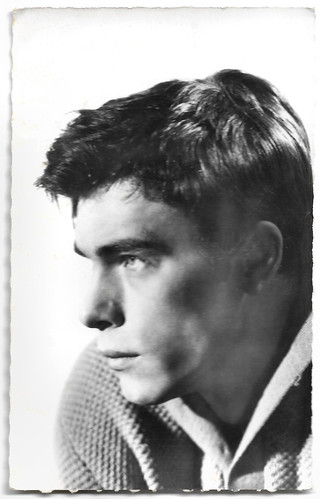
French postcard by Editions du Globe, Paris, no. 776. Photo: Studio Vauclair.

French Postcard by Editions La Malibran, Paris, no. T 2. Photo: Claude Schwartz.
Laurent Terzieff was born Laurent Didier Alex Laurent Tchemerzine in 1935 in Toulouse, France. He was the son of a French visual artist and a Russian sculptor who had emigrated to France during the First World War.
The spectacle of the bombardments during WW II had a dramatic effect on nine-year-old Laurent. As an adolescent, he was fascinated with philosophy and poetry.
He assisted director Roger Blin with the production of the play La Sonate des spectres (The Ghost Sonata) by August Strindberg. Then and there, he decided to become an actor.
Terzieff made his debut in 1953 with the Theatre of Babylon in Tous contre Adamov (All Against Adamov) by Jean-Marie Serreau. His film début was opposite Yves Montand in Premier mai/The First of May (Luis Saslavsky, 1958).
A year earlier, he had gained some notoriety playing a role as an assassin in L'affaire Weidmann/The Weidmann case (Jean Prat, 1957), an episode of the TV series En votre âme et conscience/conscience (1954-1969).
Legendary director Marcel Carné spotted him and offered him a leading role opposite Pascale Petit, Jacques Charrier and Jean-Paul Belmondo in Les Tricheurs/The Cheats (Marcel Carné, 1958), a portrait of the existentialist youth in the late 1950s.
At AllMovie, Hal Erickson writes: “Carné's youthful characters are not so many people as symbols of the postwar relaxation of worldwide manners and mores. In anticipation of the hippie flicks of the 1960s, the main characters indulge in a great deal of sex, but abstain from true love and commitment, citing these things as irrelevant in a world full of instant gratification.“
Les Tricheurs was Terzieff’s breakthrough in the cinema. For a long time, the public would identify him with the bohemian and cynical student.

French Postcard by Editions P.I., Paris, offered by Les Carbones Korès 'Carboplane', no. 1007. Photo: Studio Vallois.

French Postcard by St. Anne, Marseille. Photo: Sam Lévin.
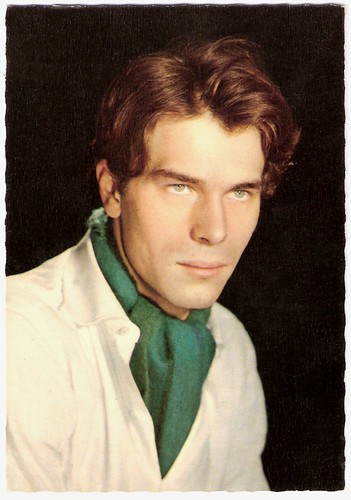
French postcard by E.D.U.G., no. 71. Photo: Sam Lévin.
Laurent Terzieff played roles in films by such famous directors as Gillo Pontecorvo in Kapò (1959) about a young Jewish girl (Susan Strasberg) who leads an escape attempt from a concentration camp, Claude Autant-Lara in Tu ne tueras point/Thou Shalt Not Kill (1961), a portrait of a conscientious objector, and Jacques Demy in the portmanteau (omnibus film) Les Sept Péchés/The Seven Deadly Sins (1962). He appeared in a segment about the lusty conversation between two young men, one of whom has x-ray eyes that enable him to see through women's clothing.
Terzieff starred with Rosanna Schiaffino and Elsa Martinelli in the Italian film La Notte Brava/Bad Girls Don't Cry (Mauro Bolognini, 1959). Pier Paolo Pasolini wrote this social drama about three young Roman criminals and three beautiful prostitutes without any perspective in life but having some money to spend during a night of illusions and adventures.
More famous Italian film directors would ask him for their films. Terzieff appeared as a revolutionary on the run from government troops in Vanina Vanini/The Betrayer (Roberto Rossellini, 1961), as the centaur in Medea (Pier Paolo Pasolini, 1969) opposite Maria Callas, as an anarchistic petty thief in Ostia (Sergio Citti, Pier Paolo Pasolini, 1970), and as a military in Il deserto dei Tartari/Desert of the Tartars (Valerio Zurlini, 1976) opposite Vittorio Gassman and Jacques Perrin.
In France, he played in A cœur joie/Two Weeks in September (Serge Bourguignon, 1967) with Brigitte Bardot, and La Prisonnière/Woman in Chains (Henri Georges Clouzot, 1968), in which he interpreted a disturbed modern art gallery owner who manipulates Elisabeth Wiener.
He made four films with director Philippe Garrel. Le Révélateur/The developper (Philippe Garrel, 1968) was shot in May 1968 during the student revolution, and Les hautes solitudes (Philippe Garrel, 1974), a biographical film about actress Jean Seberg.
Terzieff worked with more great auteurs. Famous Spanish director Luis Buñuel took him and Paul Frankeur on a pilgrimage to Santiago de Compostela in La Voie lactée/The Milky Way (Luis Buñuel, 1969). He was once directed by Jean-Luc Godard inDétective/Detective
(Jean-Luc Godard, 1985). 
Italian postcard by Rotalfoto, Milano, no. 996.

French postcard by Editions du Globe, Paris, no. 776. Photo: Studio Vauclair.

French Postcard by Editions La Malibran, Paris, no. T 2. Photo: Claude Schwartz.
Bohemian and cynical student
Laurent Terzieff was born Laurent Didier Alex Laurent Tchemerzine in 1935 in Toulouse, France. He was the son of a French visual artist and a Russian sculptor who had emigrated to France during the First World War.
The spectacle of the bombardments during WW II had a dramatic effect on nine-year-old Laurent. As an adolescent, he was fascinated with philosophy and poetry.
He assisted director Roger Blin with the production of the play La Sonate des spectres (The Ghost Sonata) by August Strindberg. Then and there, he decided to become an actor.
Terzieff made his debut in 1953 with the Theatre of Babylon in Tous contre Adamov (All Against Adamov) by Jean-Marie Serreau. His film début was opposite Yves Montand in Premier mai/The First of May (Luis Saslavsky, 1958).
A year earlier, he had gained some notoriety playing a role as an assassin in L'affaire Weidmann/The Weidmann case (Jean Prat, 1957), an episode of the TV series En votre âme et conscience/conscience (1954-1969).
Legendary director Marcel Carné spotted him and offered him a leading role opposite Pascale Petit, Jacques Charrier and Jean-Paul Belmondo in Les Tricheurs/The Cheats (Marcel Carné, 1958), a portrait of the existentialist youth in the late 1950s.
At AllMovie, Hal Erickson writes: “Carné's youthful characters are not so many people as symbols of the postwar relaxation of worldwide manners and mores. In anticipation of the hippie flicks of the 1960s, the main characters indulge in a great deal of sex, but abstain from true love and commitment, citing these things as irrelevant in a world full of instant gratification.“
Les Tricheurs was Terzieff’s breakthrough in the cinema. For a long time, the public would identify him with the bohemian and cynical student.

French Postcard by Editions P.I., Paris, offered by Les Carbones Korès 'Carboplane', no. 1007. Photo: Studio Vallois.

French Postcard by St. Anne, Marseille. Photo: Sam Lévin.

French postcard by E.D.U.G., no. 71. Photo: Sam Lévin.
Famous directors
Laurent Terzieff played roles in films by such famous directors as Gillo Pontecorvo in Kapò (1959) about a young Jewish girl (Susan Strasberg) who leads an escape attempt from a concentration camp, Claude Autant-Lara in Tu ne tueras point/Thou Shalt Not Kill (1961), a portrait of a conscientious objector, and Jacques Demy in the portmanteau (omnibus film) Les Sept Péchés/The Seven Deadly Sins (1962). He appeared in a segment about the lusty conversation between two young men, one of whom has x-ray eyes that enable him to see through women's clothing.
Terzieff starred with Rosanna Schiaffino and Elsa Martinelli in the Italian film La Notte Brava/Bad Girls Don't Cry (Mauro Bolognini, 1959). Pier Paolo Pasolini wrote this social drama about three young Roman criminals and three beautiful prostitutes without any perspective in life but having some money to spend during a night of illusions and adventures.
More famous Italian film directors would ask him for their films. Terzieff appeared as a revolutionary on the run from government troops in Vanina Vanini/The Betrayer (Roberto Rossellini, 1961), as the centaur in Medea (Pier Paolo Pasolini, 1969) opposite Maria Callas, as an anarchistic petty thief in Ostia (Sergio Citti, Pier Paolo Pasolini, 1970), and as a military in Il deserto dei Tartari/Desert of the Tartars (Valerio Zurlini, 1976) opposite Vittorio Gassman and Jacques Perrin.
In France, he played in A cœur joie/Two Weeks in September (Serge Bourguignon, 1967) with Brigitte Bardot, and La Prisonnière/Woman in Chains (Henri Georges Clouzot, 1968), in which he interpreted a disturbed modern art gallery owner who manipulates Elisabeth Wiener.
He made four films with director Philippe Garrel. Le Révélateur/The developper (Philippe Garrel, 1968) was shot in May 1968 during the student revolution, and Les hautes solitudes (Philippe Garrel, 1974), a biographical film about actress Jean Seberg.
Terzieff worked with more great auteurs. Famous Spanish director Luis Buñuel took him and Paul Frankeur on a pilgrimage to Santiago de Compostela in La Voie lactée/The Milky Way (Luis Buñuel, 1969). He was once directed by Jean-Luc Godard in
On television, he appeared in the American-Italian Mini-Series Moses the Lawgiver/Moses (Gianfranco De Bosio, 1974) starring Burt Lancaster.

French Postcard by Editions P.I., Paris, offered by Les Carbones Korès 'Carboplane', no. 963. Photo: Studio Vauclair.

French Postcard by Editions P.I., Paris, offered by Les Carbones Korès 'Carboplane', no. 994. Photo: De Kermadec.
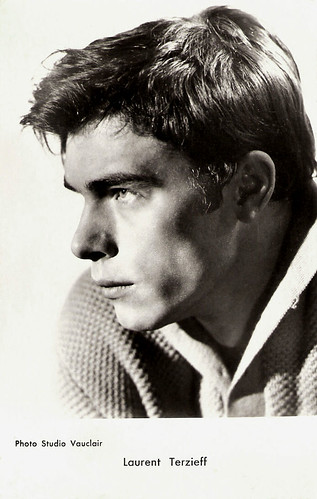
French Postcard by Editions P.I., Paris, no. 1099. Photo: Studio Vauclair.
Director, writer and actor
Since the 1980s, Laurent Terzieff was seen less in the cinemas and mostly acted on stage. In the theatre, he often worked as a director, writer and actor with his own troupe, co-founded in 1961 with his companion Pascale de Boysson. He also ran the theatre Lucernaire in Paris.
His later film roles include a Trotskyist in Rouge Baiser/Red Kiss (Véra Belmont, 1985), an anarchist in Germinal (Claude Berri, 1993) starring Gérard Depardieu, and the painter Hérigault in Le radeau de la Méduse/The Raft of the Medusa (Iradj Azimi, 1994), inspired by a tragic maritime event that happened in 1816.
Politically engaged, Terzieff signed in 1960 La Déclaration sur le droit à l'insoumission dans la Guerre d'Algérie (Declaration on the Right of Insubordination in the War of Algeria), and in 2002, the petition Pas en notre nom (Not in our name) against the Iraq War.
In his seventies, the gaunt-faced actor had not lost his magnetism, as was proved by his appearance in the Agatha Christie adaptation Mon petit doigt m'a dit.../A Little Bird Told Me... (Pascal Thomas, 2005) with Catherine Frot and André Dussollier.
Terzieff also stayed active in the theatre. In 2009 he played an acclaimed Philoctetes in the play by Sophocles.
His last films were the comedy J'ai toujours rêvé d'être un gangster/I always dreamed of being a gangster (Samuel Benchetrit, 2008) with Jean Rochefort, and the Italian production Le ombre rosse/The Red Shadow (Francesco Maselli, 2009). Posthumously he was seen opposite Sharon Stone in the thriller Largo Winch 2/The Burma Conspiracy (Jérôme Salle, 2011).
During his long career, Laurent Terzieff was hailed with many awards (Prix Gérard Philippe, Molière for Best Director and Best Show for Temps contre temps (Time against time) in 1993), and he was also an Officier de l'Ordre du Mérite (Officer of the Order of Merit) and Commandeur des Arts et des Lettres (Commander of Arts and Letters).
Laurent Terzieff died in 2010 in Paris from a lung ailment. He was 75. He was the widower of actress Pascale de Boysson.
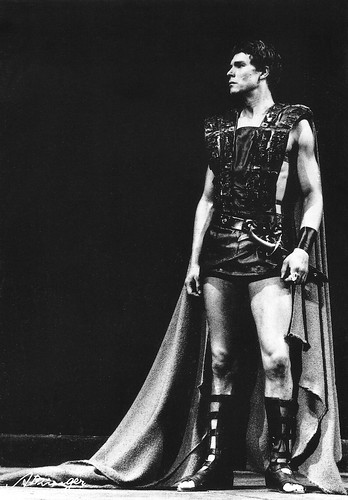
French postcard by Images d'Avignon, Avignon. Photo: Altzinger. Laurent Terzieff in the play 'Nicomède' (1964) by Pierre Corneille at the XVIIIe Festival d'Avignon (1964).

East-German postcard by VEB Progress Film-Vertrieb, Berlin, nr. 2992, 1967. Photo: Progress.

French photo.
Sources: Hans Beerekamp (Het Schimmenrijk) (Dutch), Hal Erickson (AllMovie), Evene.fr (French), Ciné-Ressources (Cinémathèque française) (French), Wikipedia (French and English), and IMDb.
What a gorgeous man. I love that he played the centaur opposite Callas! And after reading this I scroll down to another breath-taking beauty, Hedy Lamarr. Thanks Bob, these are wonderful posts.
ReplyDeleteOooo, Laurent has great eyes... :) Happy PFF!
ReplyDeletebrilliant post! i must go back and re-watch Medea on dvd...i would never have recognised him as the centaur!
ReplyDeleteMaybe the French found him handsome - I'm rather -meh-. Still a great post!!!
ReplyDeleteSomeone else with amazing eyes! Perhaps that comes with being an actor/actress? Wonderful! Happy PFF!
ReplyDeleteEnjoyed your informative post and the trailers - as always. Happy PFF!
ReplyDeleteI love the look of the old classic black and white films. He is a nice look Frenchman.
ReplyDeleteJudy
Bob, Excuse me if I say, he's a Jimmy Dean time, sexy and brooding. I don't know if he was a better actor, though... :)
ReplyDeleteHappy PFF!
ReplyDeleteWhat a handsome fellow! Thanks for sharing:)
ReplyDeleteHe looks handsome in the second shot, he got beautiful eyes.
ReplyDeleteMy Bangkok Through My Eyes
Thailand In Photo
What a handsome man! From where I am, there's a French channel on local cable television showing old French movies. I think I might have seen him in one the movies I saw.
ReplyDeleteI don't recognize the good looking fellow in this post, but I certainly do all the others before and after. They were all on screen when I was a young girl. Back when it cost 10 cents for kids and 25 cents for adults to go to the "show". You also had a short subject, cartoon, newsreel, and coming attractions. You certainly got a bank for your buck back then! Happy PPF! Carol
ReplyDeleteI remember Germinal well. Another long career.
ReplyDelete